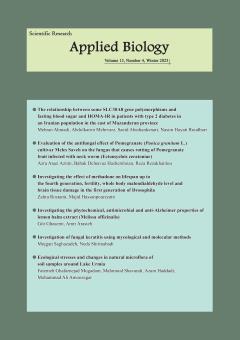بررسی مقاومت آنتی بیوتیکی و پتانسیل ایجاد بیوفیلم توسط ایزولههای سودوموناس آئروژینوزا جداسازی شده از بیمارستانهای شهر کرمان
الموضوعات :
ام البنین هابیلی
1
![]() ,
فرخ رخ بخش زمین
2
,
فرخ رخ بخش زمین
2
![]()
1 - گروه میکروبیولوژی، واحد کرمان، دانشگاه آزاد اسلامی، کرمان، ایران
2 - گروه میکروبیولوژی، واحد کرمان، دانشگاه آزاد اسلامی، کرمان، ایران
الکلمات المفتاحية: مقاومت آنتی بیوتیکی, بیوفیلم, ایزولههای سودوموناس آئروژینوزا, بیمارستانهای شهر کرمان.,
ملخص المقالة :
هدف: سودوموناس آئروژینوزا یکی از عوامل ایجادکننده عفونتهای ثانویه اکتسابی میباشد. این باکتری باعث ایجاد عفونتهای بیمارستانی ازجمله زخمهای جراحی، سوختگی و عفونت مزمن ریوی میشود. در این راستا، پژوهش حاضر با هدف بررسی مقاومت آنتی بیوتیکی و پتانسیل ایجاد بیوفیلم توسط نژادهای سودوموناس آئروژینوزا ایزوله شده از بیمارستانهای شهر کرمان انجام شده است.
مواد و روشها: مطالعه توصیفی- مقطعی حاضر بر روی 70 نمونه بالینی بیمارستانی انجام شد. ابتدا آزمایشهای بیوشیمیایی بر روی نمونهها به منظور جداسازی و تایید جنس سودوموناس آئروژینوزا انجام گرفت. الگوی مقاومت آنتی بیوتیکی سویهها به روش انتشار دیسک برای 11 آنتی بیوتیک تعیین شد. سپس توانایی تشکیل بیوفیلم در این سویهها مورد ارزیابی قرار گرفت.
یافتهها: تعداد 29 ایزوله سودوموناس آئروژینوزا به وسیله آزمایشات بیوشیمیایی از 70 نمونه بالینی بیمارستانی جداسازی شد که از این تعداد 16 سویه سودوموناس آئروژینوزا مولد بیوفیلم بودند. بیشترین مقاومت آنتی بیوتیکی در سنجش مقاومت آنتی بیوتیکی به ترتیب مربوط به ایمی پنم (24/17%)، مروپنم (58.27%)، سفوتاکسیم (06/62%)، آزترونام، (86/75%)، توبرامایسین، (27/48%)، سفپینم (37/41%)، سیپروفلوکساسین (48/34%)، سفوکسیتین (27/48%)، سفتازیدیوم (27/48%)، کلستین (03/31%)، سفامایسین (27/48%) بود.
نتیجهگیری: نتایج مطالعه حاضر نشاندهنده افزایش روند مقاومت آنتی بیوتیکی سودوموناس آئروژینوزا به آنتی بیوتیکهای مورد بررسی و گسترش ایزولههای بالینی مولد بیوفیلم است. لذا با توجه به اهمیت بالینی این سویه مقاوم در بیمارستانها، شناسایی سریع آن و بهکارگیری ابزارهای مناسب کنترل عفونت جهت جلوگیری از انتشار بیشتر این ارگانیسم ضروری است.
1. Roshani Asl P & et al. Survey of Antibiotic Resistance and Relationship Between Eesterase (estA) Gene with Biofilm Formation in Pseudomonas Aeruginosa Strains Isolated from Burn Patients. Journal of Advanced Biomedical Sciences. 2019; 9(3): 1577-1584.
2. SAINI H, Chhibber S & Harjai K. Azithromycin and ciprofloxacin: a possible synergistic combination against Pseudomonas aeruginosa biofilm-associated urinary tract infections. International journal of antimicrobial agents. 2015; 45(4): 359-367.
3. Ciofu O & Tolker-nielsen T. Tolerance and resistance of Pseudomonas aeruginosa biofilms to antimicrobial agents—how P. aeruginosa can escape antibiotics. Frontiers in microbiology. 2019; 10: 913.
4. Tabasi M, Javadinia Sh, Masoumi Asl H, Nemati AM, Azizian R, Alipour M & Tabatabai AD. Antibiotic resistance and biofilm formation ability in Pseudomonas aeruginosa isolates Isolated from patients with urinary tract infections. Infectious and Tropical Diseases Quarterly affiliated to the Association of Infectious and Tropical Diseases Specialists. 2017; 20(77): 63-68.
5. Resalati Z, Mahdavi Ortakand M & Honarmand Jahromi S. Evaluation of biofilm formation and determination of antibiotic resistance pattern in clinical isolates of Pseudomonas aeruginosa. Iranian Journal of Biological Sciences. 2017; 12(4): 23-29. [in persian]
6. Mardaneh J, Ahmadi KH & Jahan Sepas A. Determination antimicrobial resistance profile of Pseudomonas aeruginosa strains isolated from hospitalized patients in Taleghani Hospital (Ahvaz, Iran) from 2011-2012. JFUMS. 2013; 3(3): 188-193. [in persian]
7. Olivares E & et al. Clinical impact of antibiotics for the treatment of Pseudomonas aeruginosa biofilm infections. Frontiers in microbiology. 2020; 2894.
8. Pang, Z & et al. Antibiotic resistance in Pseudomonas aeruginosa: mechanisms and alternative therapeutic strategies. Biotechnology advances. 2019; 37(1): 177-192.
9. Poudyal B & Sauer K. The PA3177 gene encodes an active diguanylate cyclase that contributes to biofilm antimicrobial tolerance but not biofilm formation by Pseudomonas aeruginosa. Antimicrobial Agents and Chemotherapy. 2018; 62(10).
10. Torrens G & et al. Activity of ceftazidime-avibactam against clinical and isogenic laboratory Pseudomonas aeruginosa isolates expressing combinations of most relevant β-lactam resistance mechanisms. Antimicrobial agents and chemotherapy. 2016; 60(10): 6407-6410.
11. Ahmed MN & et al. Evolution of antibiotic resistance in biofilm and planktonic Pseudomonas aeruginosa populations exposed to subinhibitory levels of ciprofloxacin. Antimicrobial agents and chemotherapy. 2018; 62(8).
12. Rybtke M & et al. Pseudomonas aeruginosa biofilm infections: community structure, antimicrobial tolerance and immune response. Journal of molecular biology. 2015; 23(427): 3628-3645.
13. Falcone M & et al. Dissecting the role of the small RNA ErsA in Pseudomonas aeruginosa motility and biofilm regulation. 2017. URL= https://air.unimi.it/retrieve/dfa8b999-279f-748b-e053-3a05fe0a3a96/FEMS%202017%20Marilena%20Falcone_abstract.pdf
14. CLSI. Performance standards for antimicrobial susceptibility testing. twenty-six information supplements: Clinical and Laboratory Standards Institute, Wayne, PA; 2016.
URL= https://clsi.org/media/wi0pmpke/m100ed32_sample.pdf
15. Habibi A & et al. The frequency and antibiotic resistance modeling in clinical strains of Pseudomonas aeruginosa isolated from different parts of Tehran hospitals. Razi Journal of Medical Sciences. 2016; 23(146): 10-16. [in persian]
16. Nooritalab N & et al. Frequency of multidrug-resistant Pseudomonas aeruginosa in patients with ventilator associated pneumonia. Razi Journal of Medical Sciences. 2013; 20(112):
16-23. [in persian]
17. Kamali E & et al. Evaluation of antimicrobial resistance, biofilm forming potential, and the presence of biofilm-related genes among clinical isolates of Pseudomonas aeruginosa. BMC research notes. 2020; 13: 1-6.
18. Ratajczak M & et al. Relationship between antibiotic resistance, biofilm formation, genes coding virulence factors and source of origin of Pseudomonas aeruginosa clinical strains. Annals of Agricultural and Environmental Medicine. 2021; 28(2): 306-313.
19. Heydari S & Eftekhar F. Biofilm formation and β-lactamase production in burn isolates of Pseudomonas aeruginosa. Jundishapur journal of microbiology. 2015; 8(3).
20. Karami P & et al. The correlation between biofilm formation capability and antibiotic resistance pattern in Pseudomonas aeruginosa. Gene Reports. 2020; 18: 100561.
21. Ghotaslou R & et al. Antibacterial Effects of Azerbaijan honey on Pseudomonas aeruginosa biofilm. Iranian Journal of Medical Microbiology. 2016; 9(4): 40-46. [in persian]


